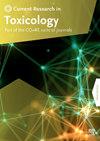Effects of mineral fibres in an in vitro placental syncytiotrophoblast model
IF 2.9
Q2 TOXICOLOGY
引用次数: 0
Abstract
It is known that mineral fibres can be found in placental tissues, but their effect is not known on these tissues. BeWo in vitro model of syncytiotrophoblast, the outer layer of maternal-foetal barrier, is necessary to understand if mineral fibres can alter placental cell turnover and consequently to influence the outcome of pregnancy. We performed in vitro experiments using chrysotile UICC (UICC), chrysotile Valmalenco (VM) and erionite (ERI) to investigate the potential cytotoxic effects of these mineral fibres on BeWo cells. We demonstrated that all fibres are toxic while only UICC fibres caused a DNA damage that the cells were not able to repair through RAD51 activity. In addition, we demonstrated that DNA replication is not altered while cyclin D1 showed a significant decrease in VM and UICC suggesting that the cell cycle is altered in G1 phase. Moreover, UICC increased active form of caspase 3 demonstrating that apoptosis can be induced in BeWo cells. We suggest that although morphological changes are not visible in BeWo cells treated with these mineral fibres, DNA damage can lead to altered placenta physiology that can be seen late when the damage at the foetal tissues has already occurred.

矿物纤维对体外胎盘合体滋养细胞模型的影响
众所周知,在胎盘组织中可以发现矿物纤维,但它们对这些组织的影响尚不清楚。BeWo体外合胞滋养细胞(母胎屏障的外层)模型对于了解矿物纤维是否可以改变胎盘细胞的更新从而影响妊娠结局是必要的。我们使用温石棉UICC (UICC)、温石棉Valmalenco (VM)和钙离子石(ERI)进行体外实验,研究这些矿物纤维对BeWo细胞的潜在细胞毒性作用。我们证明了所有的纤维都是有毒的,而只有UICC纤维引起细胞无法通过RAD51活性修复的DNA损伤。此外,我们证明DNA复制没有改变,而cyclin D1显示VM和UICC显著减少,表明细胞周期在G1期发生改变。此外,UICC增加了caspase 3的活性形式,表明可以诱导BeWo细胞凋亡。我们认为,虽然用这些矿物纤维处理的BeWo细胞不可见形态变化,但DNA损伤可导致胎盘生理学改变,当胎儿组织损伤已经发生时,可以看到这种改变。
本文章由计算机程序翻译,如有差异,请以英文原文为准。
求助全文
约1分钟内获得全文
求助全文
来源期刊

Current Research in Toxicology
Environmental Science-Health, Toxicology and Mutagenesis
CiteScore
4.70
自引率
3.00%
发文量
33
审稿时长
82 days
 求助内容:
求助内容: 应助结果提醒方式:
应助结果提醒方式:


